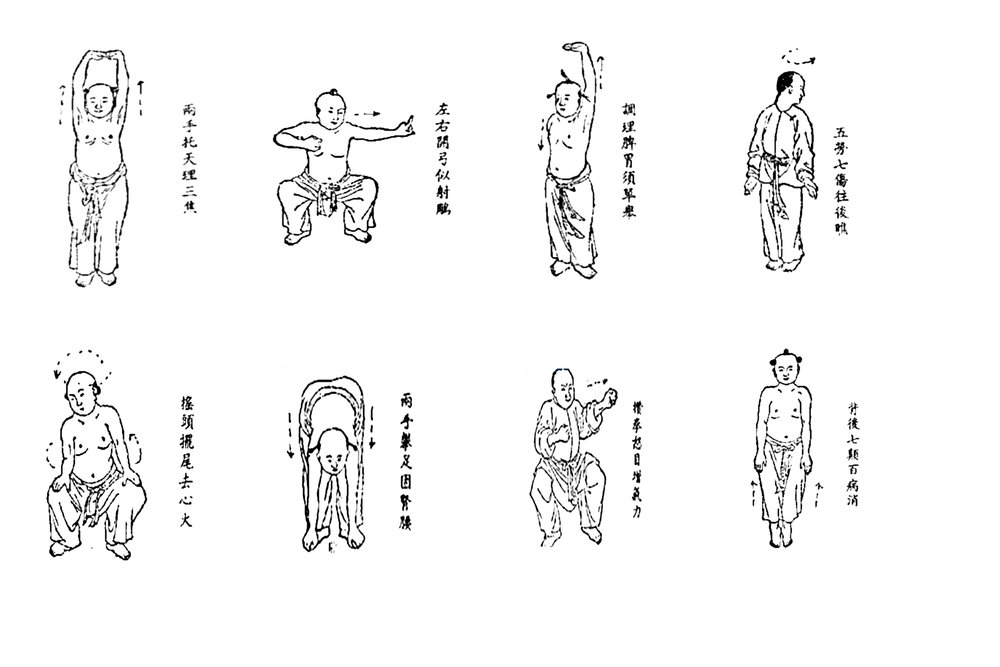Tai Chi for Better Health primarily trains instructors to teach sets of Shibashi. These contemporary Qigong sequences are largely adapted from traditional forms. While several of the exercises are drawn directly from Yang Family Style Tai Chi, roots of other forms can be discerned, such as in Ba Duan Jin.
An ancient and traditional form of Qigong, Ba Duan Jin exhibits multiple existence and variation. Ba Duan Jin translates into English as eight sections or movements.
Ba means eight (as in Shi-ba-shi), Duan signifies pieces or sections and Jin refers to tendons and sinews, which are symbolised by the finest silk or brocade. The reference to brocade or silk (brocade fabric is generally made with silk threads) is believed to metaphorically reflect the flow of continual movement akin to drawing silk from a cocoon.
Variations of this traditional set are also known as Eight Pieces of Brocade, Eight Pieces of Embroidery, Eight Silks Brocade, Eight Treasures, Eight Tibetan Ancestors, Regular Eight, Eight Section Brocade and Golden Eight.
There are several accounts of its origins and lineage: Ba Duan Jin derived from the Yi Jin Jing series of exercises; Ba Duan Jin is rooted in Vedic Yogic teaching; and, according to legend, Ba Duan Jin was created by the famous Sung General Yue Fei (1177-1279AD) in order to prepare his soldiers for the battlefield.
Archaeological evidence points to a precursor of Qigong practiced during the Han Dynasty (206BC-220AD); a time of high production of fine textiles and treasured brocades and silks. An intricately painted brocade called Illustration of Qi Conduction was excavated during the 1970s; four of the illustrations of figures exercising reveal commonalities with Ba Duan Jin.
During the Southern and Northern Dynasties (420-589AD), similar illustrations are found in a book entitled On Caring for the Health of the Mind and Prolonging the Lifespan written by Tao Hongjing.
The earliest written mention of the name Ba Duan Jin comes from descriptions and illustrations found in a book called Record of the Listener-Selections of Chinese Supernatural Stories, written by Hong Mai during the Southern Song Dynasty (1127-1279AD). An illustrated manual entitled Newly-published Health and Fitness Illustrations-Ba Duan Jin created during the Qing Dynasty (1644-1911AD) names and describes the standing postures of Ba Duan Jin.
Practice can be divided into two major styles: Standing and sitting; the former gentler style is prevalent in the Southern School, while the latter firmer style belongs to the Northern School. It should be noted that they are not mutually exclusive. Thus, Ba Duan Jin has been modified over the centuries, promoted and developed by many schools of thought, and practised by the general populace, Shaolin Monks and Southern Song military alike.
In 2001, the Taiji and Qigong department of the Chinese National Sports Committee oversaw a study involving experts from a number of fields including physiology, kinetics and sports medicine in an effort to standardize and legitimise an official version of Ba Duan Jin. Nevertheless, a plethora of variations continue to be practised all around the world.
Studying other forms of Qigong can enhance your own Shibashi practice and expand your teaching repertoire. For example, the logic of Set 1’s derivative Punching is elucidated by unravelling the ancient mechanics of the seventh silk brocade, Punching with Angry Eyes.
If you would like to find out more about learning Ba Duan Jin, contact Senior Instructor Mabli at taichiforbetterhealth@outlook.com
References
Chinese Health Qigong Association, comp. Ba Duan Jin. Foreign Languages Press: Beijing, 2007.
Tai Chi Notebook. September 27, 2015. https://taichinotebook.com/2015/09/27/history-of-baduanjin/ (accessed 7 December, 2021)


Leave a Reply